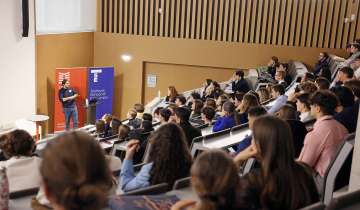10 septembre - soutenance de thèse de Miren AZKARATE-ASKASUA
Madame Miren AZKARATE-ASKASUA soutiendra sa thèse de doctorat en Sciences économiques le 10 septembre 2020 à 11h00
Visioconférence (TSE) https://zoom.us/j/92280832061
Sur le sujet : “Essays on Macroeconomics and Labor Markets”
Directeur de thèse: Professeur Christian HELLWIG
Le jury se compose comme suit :
Professeur Jean-Marc ROBIN, Sciences-Po et UCL
Professeure Uta SCHÖNBERG, University College London
Professeur Fabrice COLLARD, UT1 Capitole
Professeur Christian HELLWIG, UT1 Capitole
Résumé (en anglais)
This thesis contains three essays on the macroeconomic effects of labor markets with a special emphasis on market power and the determination of wages.
In the first chapter, Miguel Zerecero and I study the efficiency and welfare effects of employer and union labor market power. We use data of French manufacturing firms to first document a negative relationship between employment concentration and wages and labor shares. At the micro-level, we identify the effects of employment concentration thanks to mass layoff shocks to competitors. Second, we develop a bargaining model in general equilibrium that incorporates employer and union labor market power. The model features structural labor wedges that are heterogeneous across firms and potentially generate misallocation of resources. We propose an estimation strategy that separately identifies the structural parameters determining both sources of labor market power. Furthermore, we allow different parameters across industries which contributes to the heterogeneity of the wedges. We show that observing wage and employment data is enough to compute counterfactuals relative to the baseline. Third, we evaluate the efficiency and welfare losses from labor market distortions. Eliminating employer and union labor market power increases output by 1.6\% and the labor share by 21 percentage points translating into significant welfare gains for workers. Workers' geographic mobility is key to realize the output gains from competition.
In the second chapter, Miguel Zerecero and I propose a bias correction method for estimations of quadratic forms in the parameters of linear models. It is known that those quadratic forms exhibit small-sample bias that appears when one wants to perform a variance decomposition such as decomposing the sources of wage inequality. When the number of covariates is large, the direct computation for a bias correction is not feasible and we propose a bootstrap method to estimate the correction. Our method accommodates different assumptions on the structure of the error term including general heteroscedasticity and serial correlation. Our approach has the benefit of correcting the bias of multiple quadratic forms of the same linear model without increasing the computational cost and being very flexible. We show with Monte Carlo simulations that our bootstrap procedure is effective in correcting the bias and we compare it to other methods in the literature. Using administrative data for France, we apply our method by doing a variance decomposition of a linear model of log wages with person and firm fixed effects. We find that the person and firm effects are less important in explaining the variance of log wages after correcting for the bias.
In the third chapter, I study peer effects at the workplace. I focus on how potential peers determine a worker's location and her future wage profile. I empirically disentangle if workplace peers affect each other through learning or network effects. Similarly to the literature, I document the importance of learning which is more pronounced for the youngest cohorts arguably with no networks. I propose a structural model to understand the mechanism behind learning. The final goal of the model is to quantify the impact of peer learning the firm geographical allocation of workers, and on the rising between firm wage inequality.



